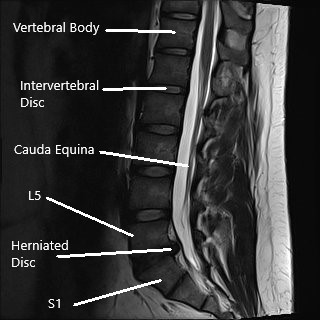Case Study: Selective Nerve Block in a
32-year-old Female with Lumbar Radiculopathy
The patient is a 32-year-old female who presented to our office with complaints of worsening radiating pain in the back of the right thigh. The radiating pain started after the patient was involved in a motor vehicle accident six months ago. The pain was initially located in the lower back and associated with radiation along the right buttock and back of the thigh.
The patient initially followed conservative management in the form of nonsteroidal anti-inflammatory medications such as ibuprofen and started physical therapy. The medications initially helped her pain but the relief did not last long. The patient describes the pain as sharpshooting in character and severe in intensity. The pain is associated with a tingling sensation in the right sole.
Activities such as bending forward, lifting, walking, sitting, coughing, sneezing make the symptoms worse. The patient reports heat and icing make the symptoms better but only temporarily. The patient works as a warehouse worker and states the pain interferes with her work. The patient’s medical history is unremarkable and reports a prior shoulder arthroscopy surgery. The patient is a nonsmoker and denies the use of any illicit drugs.
On physical examination of the lumbar spine, there was tenderness to palpation of the paraspinal muscles at L5. The range of motion was limited secondary to pain with lateral flexion to the left (20 deg.) and the right (20 deg.); rotation to the left (20 deg.) and the right (20 deg.); and flexion (40 deg.), extension (10 deg.). The straight leg raise test on the right was positive at 45 degrees. The power and sensory examination of the lower extremities were normal.

MRI image of the lumbar spine in the sagittal section showing herniated disc.
MRI studies of the lumbar spine suggested at L5-S1 a central protruding disc herniation that impinges the descending right S1 nerve root and mildly narrows the spinal canal. Various treatment options were discussed with the patient. A discussion was done regarding getting a selective nerve root block done.
The risks and benefits including infection, bleeding, injury to the nerve, temporary or permanent numbness or stiffness, externalization of the drug into the vessel, and complications therefore including weakness, tingling, and numbness into the right leg among others were discussed at length with the patient. The patient understood and signed the informed consent.
MRI of the L5-S1 in axial section showing herniated disc.
PREOPERATIVE DIAGNOSIS: Radiculopathy, right S1.
POSTOPERATIVE DIAGNOSIS: Radiculopathy, right S1.
OPERATION: Selective nerve root block transforaminal right S1.
DESCRIPTION OF PROCEDURE: The patient was taken to the procedure room and the patient was put prone on the operating table. Sedation was given. The back was prepped and draped aseptically in the usual fashion. C-arm was brought in. Visualization of the entry was done under fluoro and local anesthesia with lidocaine was done. A spinal needle was inserted along the path.
Finding the needle is a satisfactory position in the foramen, omnipaque 0.5 cc was injected. The nervogram was produced, which was saved. This was followed by an injection of 1 cc of lidocaine mixed with 40 mg of Kenalog. The needle was removed and Band-Aid was applied. The patient was moved to recovery in a stable condition.
The patient reported immediate pain relief and restarted his participation in physical therapy.
Disclaimer – Patient’s name, age, sex, dates, events have been changed or modified to protect patient privacy.

Dr. Suhirad Khokhar
My name is Dr. Suhirad Khokhar, and am an orthopaedic surgeon. I completed my MBBS (Bachelor of Medicine & Bachelor of Surgery) at Govt. Medical College, Patiala, India.
I specialize in musculoskeletal disorders and their management, and have personally approved of and written this content.
My profile page has all of my educational information, work experience, and all the pages on this site that I've contributed to.
